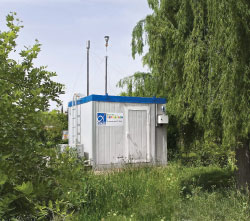
An air quality monitoring station at Athens International Airport. As part of its commitment to carbon neutrality, AIA has begun mapping its emissions.
AIA has developed into the most important air transport hub in south eastern Europe since its opening in 2001. The airport handled 16.5 million passengers in 2008, maintaining its record 2007 levels – a positive result given the challenging economic situation – and is committed to its major objective to effectively contribute to environmental protection and continuously monitor and control potential environmental impacts.
The airport has accelerated its environmental initiatives in recent years, launching its first coordinated Climate Change Corporate Action Plan in 2007. The Action Plan is updated annually and the 2009 edition includes 10 specific actions targeting reductions in aircraft and vehicle emissions, increased recycling and use of recycled materials, as well as tree-planting and ecosystem preservation initiatives. The European Commission has recognised AIA’s efforts, honouring it with the GreenBuilding Award 2008 – a significant European distinction within the framework of the voluntary GreenBuilding programme, in recognition of the energy-saving performance of its facilities.
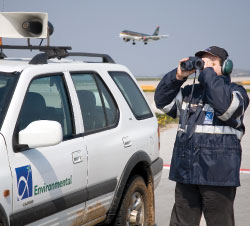
AIA is converting petrol-powered vehicles in its fleet to operate on LPG (Liquefied Petroleum Gas), which emits fewer pollutants. It has already converted 33 vehicles and plans to convert an additional 17 by the end of the year.
AIA’s participation in Airport Carbon Accreditation represents the next logical step in addressing its environmental impact by mapping, verifying and continuing its efforts to reduce its carbon footprint. “Achieving carbon neutrality certainly poses a significant challenge, but one that AIA has already begun addressing, starting with mapping the airport company’s emissions and with the implementation of the Climate Change Corporate Action Plan,” said Karamanos. “Although carbon neutrality will take several years to achieve, we are committed to continuing to enrich our portfolio of initiatives aimed at reducing emissions associated with the operation of the airport and to engage other members of the airport community in this important task.”
Recycling success
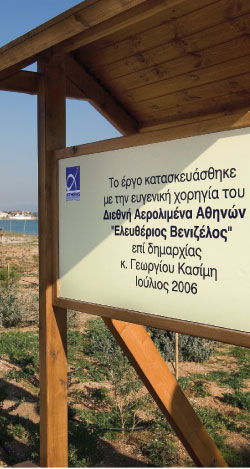
One of the more interesting environmental initiatives AIA has recently taken on is the ‘adoption’ of the Vravrona Wetlands, a local site of exceptional ecological and archaeological value.
AIA has a number of headline environmental targets that are both quantifiable and must be achieved within a specific timeframe: Achieving a recycling rate of 50% by 2012, providing environmental awareness training to 91% of AIA employees by 2010 and construction of the Spata (adjacent Municipality) park area, are chief among these.
Particular success has been in increasing the rate of recycling. AIA implements a comprehensive waste management programme based on the ‘Polluter Pays Principle’. Waste producers are charged based on the tonnage of generated waste, obtain refunds based on the recycled quantities, participate in environmental training/meetings and are subject to audits. This programme has enabled AIA to increase recycling from a level of 2% in 2001 to an impressive 43% in 2008 (up from 34% in 2007), placing it in a strong position to achieve its target. “In 2009, we are participating in a pilot project for the recovery of recyclables from mixed waste, while we are hopeful that new infrastructure in the region will help us reuse the sludge from our sewage treatment plant. This way we will be in a position to achieve our recycling target of 50% by the year 2012,” said Karamanos.
AIA has also initiated a programme of converting petrol-powered vehicles in its fleet to operate on LPG (Liquefied Petroleum Gas), which emits fewer pollutants, including carbon dioxide, into the atmosphere. It has already converted 33 vehicles and plans to convert an additional 17 by the end of the year. Four older vehicles were also recently replaced by hybrid vehicles. Karamanos explained that the airport is closely examining more environmentally-friendly alternatives to the existing diesel-powered buses in light of the scheduled replacement of this fleet within the next couple of years. These measures are expected to reduce CO2 emissions by up to 40% per vehicle.
Alternative and renewable energy
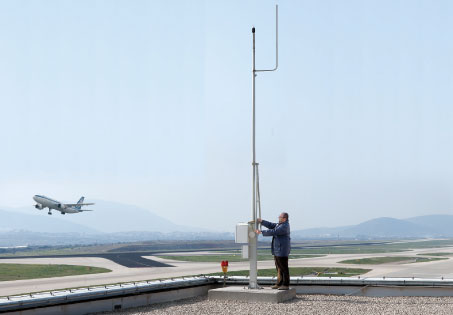
AIA has a Noise Management Plan that involves the operation of a state-of-the-art Noise Monitoring System, the enforcement of Noise Abatement Procedures with specific night-time restrictions, and Noise Mapping.
The airport’s energy-efficiency statistics are impressive – electrical consumption was reduced by 23% in its first five years of operation, for example, while more than 99% of the airport’s heating and cooking needs are covered by natural gas, with fewer emissions than diesel or electricity. Such figures were key to AIA receiving the GreenBuilding Award. “We are currently examining the possibilities of using alternative and renewable energy sources, such as photovoltaics and geothermal energy, aiming at the reduction of the inevitable impact of the airport’s energy requirements on the environment. Our next aim is to develop an 8MW Photovoltaics Park – at a cost of approximately €40 million,” said Karamanos.
Here again, the figures are significant; it is forecast that a Photovoltaics Park would produce more than 10,800 MWh per year, thereby averting the emission of more than 10,000 tonnes of CO2 annually. “The energy produced would be equivalent to about 16% of AIA’s annual electrical consumption, while in terms of the size of the CO2 aversion, one should consider that each tree absorbs approximately 6kg of CO2 each year – hence, the quantity of 10,000 tonnes per year corresponds to the absorption capacity of approximately 1.5 million trees,” said Karamanos.
Working with local communities
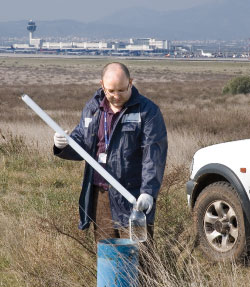
The 2009 edition of AIA’s Climate Change Corporate Action Plan includes 10 specific actions targeting reductions in aircraft and vehicle emissions, increased recycling and use of recycled materials, as well as tree-planting and ecosystem preservation initiatives.
One of the more interesting environmental initiatives AIA has recently taken on is the ‘adoption’ of the Vravrona Wetlands, a local site of exceptional ecological and archaeological value. Recent activities, performed in cooperation with the Hellenic Ornithological Society, have included a volunteer clean-up of the area on World Environment Day 2009 (5 June) as well as the creation of paths, signage and educational materials for site visitors. Five parks have already been constructed in neighbouring areas and AIA is in the process of designing and commissioning one more. The total area of these parks, which include walking paths, theatres, playgrounds and rest areas, is more than 80,000sqm. “Working with the local communities on environmental issues is an important part of our work, but one that requires long-term strategic planning, regular contact with local representatives, and an understanding of the specific needs of each community,” said Karamanos.
Noise is, naturally, a principal concern of the local community and AIA has a Noise Management Plan that involves the operation of a state-of-the-art Noise Monitoring System, the enforcement of Noise Abatement Procedures with specific night-time restrictions, and Noise Mapping for assessing effectiveness and further planning. A dedicated telephone line and website form enable local residents to register complaints and request information on noise issues. Karamanos explained that communication with local communities is also achieved through periodic meetings with representatives of local authorities.
CDA plans
AIA has already achieved notable environmental successes and has set further ambitious targets. Looking forward, there are plans to implement Continuous Descent Approach (CDA) – something the airport is discussing with the Civil Aviation Authority. “Since the implementation of the procedure will affect mostly the part of the flight where aircraft are flying over the sea during landing, we do not anticipate significant benefits with respect to noise, however we do expect important reductions in aircraft emissions,” said Karamanos.
For the remainder of 2009, AIA will assess the effectiveness of the pilot recycling project with respect to increasing the recycling rate, complete mapping of its carbon footprint in the context of participation in the Airport Carbon Accreditation scheme, launch implementation of the updated Noise Action Plan, and further strengthen relations with companies operating at the airport through the organisation of a dedicated Environmental Workshop.







